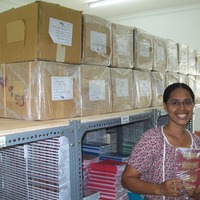- Semau island, UBB - Kupang
- +6281237902895
- Add Social Profiles(Facebook, Twitter, etc.)
Misriani Balle
Payap University, Graduate Department of Linguistics, Graduate Student
•
This volume showcases the expression of number and quantity in a dozen minority languages spoken in Eastern Indonesia. While several papers offer a typological and comparative perspective, most contributions provide detailed descriptions... more
This volume showcases the expression of number and quantity in a dozen minority languages spoken in Eastern Indonesia. While several papers offer a typological and comparative perspective, most contributions provide detailed descriptions of the numeral systems, universal quantifiers, classifiers, and the expression of nominal and verbal number in individual languages. Languages featuring in this volume include the Austronesian languages Sumbawa, Tolaki, Helong, Uab Meto, and Papuan Malay; the Timor-Alor-Pantar languages Abui, Bunaq, Kamang, Makalero, Sawila, and Western Pantar, and the West-Papuan language Tobelo.
More Info: Languages featuring in this volume include the Austronesian languages Sumbawa, Tolaki, Helong, Uab Meto, and Papuan Malay; the Timor-Alor-Pantar languages Abui, Bunaq, Kamang, Makalero, Sawila, and Western Pantar, and the West-Papuan language Tobelo.
Publisher: Asia Pacific Linguistics
Publication Date: 2014
Research Interests:
•
Elicited words and phrases from Kodi, Lamboya and Wanukaka Three audio files with time-aligned transcription files of elicited recording of the Kodi language [kod] spoken in Sumba, Indonesia. Two recordings are word lists, the other... more
Elicited words and phrases from Kodi, Lamboya and Wanukaka
Three audio files with time-aligned transcription files of elicited recording of the Kodi language [kod] spoken in Sumba, Indonesia. Two recordings are word lists, the other consists of a few short phrases.
https://catalog.paradisec.org.au/collections/JL4/
Three audio files with time-aligned transcription files of elicited recording of the Kodi language [kod] spoken in Sumba, Indonesia. Two recordings are word lists, the other consists of a few short phrases.
https://catalog.paradisec.org.au/collections/JL4/
DOI: 10.26278/5c9103fcc93b9
Publication Date: 2019
Publication Name: PARADISEC Catalog
Research Interests:
•
Kodi is a Malayo-Polynesian language spoken by about 20,000 people living in the western part of the island of Sumba (NTT, Indonesia). In 2018, a project was launched to publish school curriculum in Kodi for a multilingual education... more
Kodi is a Malayo-Polynesian language spoken by about 20,000 people living in the western part of the island of Sumba (NTT, Indonesia). In 2018, a project was launched to publish school curriculum in Kodi for a multilingual education program. This requires a standardized writing system for Kodi. One challenge for writing Kodi is that, unlike Indonesian, Kodi does not have any voiced stops; but it does have a set of implosive stops. We found three competing proposals for how to write implosive sounds. One is to use the grapheme used for the voiced stop sounds in Indonesian, co-opting <b> and <d> for the bilabial and alveolar implosives. A second proposal is to use a digraph combining the letter <h> with the grapheme representing a stop at the relevant place of articulation: <bh> and <dh>. A third proposal is to use an apostrophe as a diacritic: <b'> and <d'>. We employed three methods for working with Kodi speakers in order to come to a consensus on how to write implosives sounds. First, we worked with Kodi speakers in a two-day participatory workshop for alphabet design. Second, we designed a survey to informally check the opinions of Kodi speakers on competing proposals for writing words with implosives. Third, we organized a consultative meeting to invite the opinion of key stakeholders in the community. Through this process, we came to the tentative conclusion that there is enough community consensus to move forward with the use of the digraphs, <bh> and <dh>, to write implosives in Kodi. However, a recent publication in Kodi has caused us to re-evaluate the possible advantages of using <b> and <d> for implosives.
